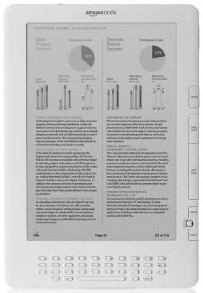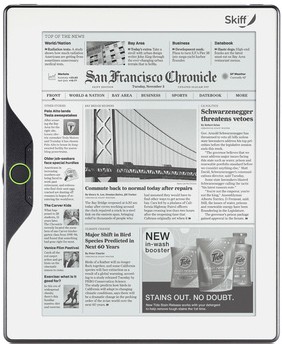Like many pharmacists I read a lot of journal articles. This is especially true because of the dual role I play at my hospital. It’s not uncommon for me to read a couple of articles a day through the week and a few more thrown in on the weekend. The articles come from various medical and technology journals that I regularly visit plus the occasional article recommended by a friend or colleague. I still receive some journals in hard copy, but many now arrive electronically. Because I look into a computer screen 12-14 hours a day, I’m not particularly fond of reading articles on my laptop or tablet pc; it gives me a headache. As I’ve said many times, looking at a normal LCD monitor is like looking into a flashlight. Instead of reading PDFs on my computer I print them out and take them with me wherever I go (I can hear the collective moan from the conservationists in the crowd; sorry). This kind of defeats the purpose of having electronic documentation and certainly isn’t very “green”. With that said, advances in e-ink technology and e-reading devices may change my approach.
I’ve been waiting for an e-reader that will allow me to read PDF files without having to zoom in and out or dance around the screen. I’ve tried reading on my Droid and my iPod Touch, and while possible, I wouldn’t want to do it for an extended period of time. It’s just not convenient.
The Kindle DX was the first e-reader to hit the market with a screen big enough to accommodate my needs, and it was my front runner for quite a while. However, before dropping $500 on the DX I wanted to see some of the new devices that have been “on their way†since early 2009. Some of these devices are listed below.
 Kindle DX
Kindle DX
The Kindle DX offers a 9.7†display and is only 0.38 inches think. The DX has 4GB of memory with approximately 3.3GB available for storage. Available for $489.00 from Amazon.
After waiting for all the new technology I’m probably still going to end up going with the Kindle DX. It has a large display, is battle tested and is the most reasonably priced of the currently available large screen e-reader devices.
Plastic Logic QUE proReader
The QUE proReader offers a 10.7†plastic touchscreen display and is only 1/3 of an inch thick. It is available in two models: a 4GB for $649.00 and an 8GB for $799.00. The Plastic Logic site is taking preorders now for the QUE proReader, which should ship sometime in April of this year.
There are two reasons I probably won’t buy a Plastic Logic device. First, they won’t be shipping until mid-April and second, the price tag. While the QUE proReader isn’t necessarily aimed at the general consumer, the cost of the device will keep many away.
 Skiff Reader
Skiff Reader
The Skiff offers an 11.5 inch “Metal Foil†touchscreen display and is only 0.25 inches thick. The Skiff Reader has 4GB of internal memory with 3+ GB available for content. No pricing information or release date is currently available
The Skiff Reader is probably the perfect device for healthcare professionals that want a true journal reading experience on an electronic device. The Skiff reader has a flexible screen and the largest reading surface of any e-reader on the market. The biggest problem is you can’t purchase one.
A different approach to reading electronic documents may come via Pixel Qi’s new transflective LCD screen. According to Gizmodo “In the Pixel Qi display’s current form, it’s impressive, though nowhere near perfect. In its backlit LCD mode, it’s just about as good as any other 10.1-inch, 1024×600 netbook display, except that the viewing angle seems more limited, before the color started warping. Head on, color seems solid. Though it won’t win any illumination showdowns, it’s plenty bright. On the Lenovo S10 used as the demo unit, it immediately switched to the electrophoretic reflective mode—where backlighting is replaced by ambient light reflecting off the back of the screen. In that mode, it really is just as crisp as the Kindle for reading text. You can watch video in this mode too, though it’s not exactly pretty (the point being you don’t have to wait 10 years for the damn screen to refresh when you turn a page). They wouldn’t speculate on how much battery life improves when you turn off the backlight, simply stating that it saves you 2 watts of power.â€

The Pixel Qi screen will be most useful when installed in some form of tablet device like the Notion Ink Adam. The tablet form factor makes reading much easier than on a laptop, especially when you’re traveling or just sitting in your favorite chair relaxing at home.
The advantages to the e-readers like the Kindle DX, QUE proReader and Skiff Reader are clear; larger reading area than mobile phones and similar devices, long battery life, light weight, and they are easy on the eyes. The disadvantages are the slow screen refresh rates associated with e-ink devices, which really isn’t that big of a problem for reading, and the cost. I’ve used a couple of e-readers, namely the Kindle and the Nook, and have found them to be quite nice.
The advantages to using a laptop, netbook or tablet pc with a Pixel Qi screen are the ability to watch video, the ability to use backlighting when needed and no need to carry a secondary reading device. The disadvantage is really the lack of battery life when compared to the dedicated e-reader devices above. Even with the improved battery life promised by the Pixel Qi technology, I don’t think it will be anywhere near currently available e-ink devices.
Leave a Reply